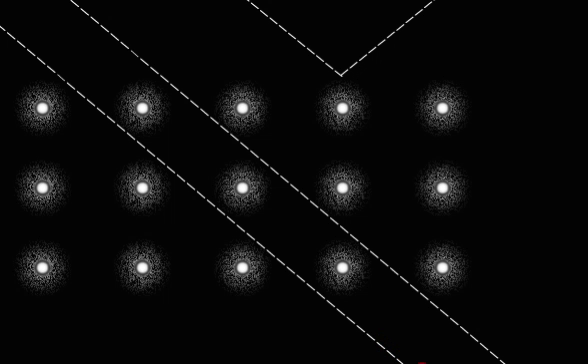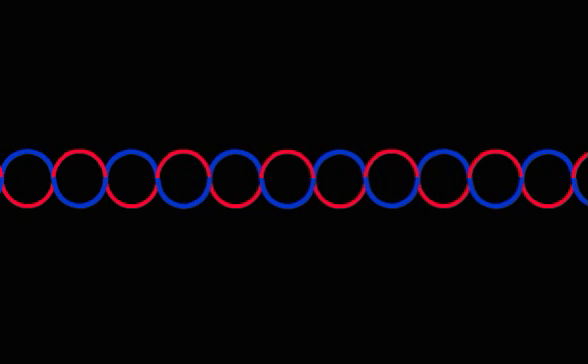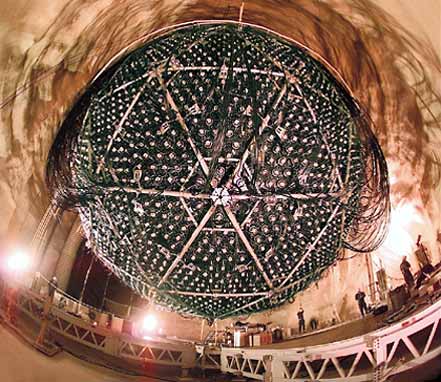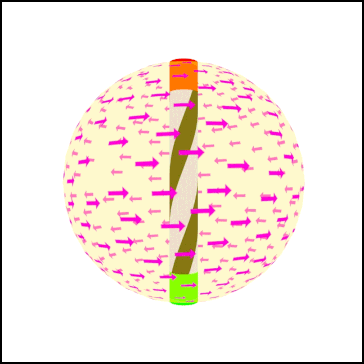CM602: Can Neutrinos be treated as tiny single Photon Hoops?
David Noel
<davidn@aoi.com.au>
Ben Franklin Centre for Theoretical Research
PO Box 27, Subiaco, WA 6008, Australia.
What are neutrinos?
According to [2], "Neutrinos are one of the fundamental particles which make up the universe. They are also one of the least understood. Neutrinos are similar to the more familiar electron, with one crucial difference: neutrinos do not carry electric charge. If neutrinos have mass, they also interact gravitationally with other massive particles, but gravity is by far the weakest of the four known forces."
Another article [3] says "Neutrinos are ghostly subatomic particles that, by all reasoning, should have a minute mass, but until now that mass has never been accurately calculated, which has posed problems with what's known as the standard model of cosmology. Neutrinos are difficult to study because they interact so weakly with matter. Neutrinos are known to oscillate, so that neutrinos of definite flavour do not have definite mass, rather they exist in a superposition of mass eigenstates."
So, what do we really know about neutrinos? They do exist, and may have mass, but this mass is not known with certainty, and may vary. Neutrinos are typically treated as particles.
Can neutrinos be treated as radiation?
Right from back in Isaac Newton's time, arguments have been raised as to whether the electromagnetic radiation we call light is made up of photons (radiation packets) or particles. Today's current view is that light has both radiation and particle aspects, and either treatment can yield useful and applicable results.
Electrons are usually treated as particles, one of the constituents of the atom. They are treated as if in orbit about the atomic nuclei, which are made up of protons and neutrons -- other particles.
But streams of electrons can also be treated as radiation, radiation with a particular wavelength. Their radiation aspect is relied upon to explain the working of electron microscopes and electron-diffraction equipment.
Within the atom, the forces holding the parts of a nucleus together (called "gluons"), may also be treated as particles. So there is no reason why any particle may not have radiation aspects, and no reason why any radiation may not have particle aspects.
The Wikipedia article on neutrinos [1] says: "Neutrinos traveling through matter, in general, undergo a process analogous to light traveling through a transparent material. This process is not directly observable because it does not produce ionizing radiation."
In this article we look at a new treatment of neutrinos as radiation, using a particular approach, the Photon Hoop Model [A] . This model combines both particle and radiation aspects of light in a single model.
In this representation, a beam of light is treated as being made up of a stream of Photon Hoops. These are two-dimensional hoops of energy which flex as they travel, alternately flattening and expanding, as in the following figures.

Figure CM602-F1. Photon Hoops striking a crystal lattice. From [4]
Part of the explanation in this model says "This figure is a representation of photon hoops striking the outer surface of a simple crystal surface. Only one slice through the grid of atoms is shown, and these are arranged in one of the simplest ways, at the corners of cubes. In the modern interpretation, each atom consists of a dense central nucleus surrounded by an electron cloud."
"This electron cloud is somewhat like the Earth's atmosphere, densest close to the solid surface or nucleus and thinning out and tailing off away from the centre, although with real atoms the 'solid' nucleus is very tiny compared to the cloud."
Each Hoop represents a half-wavelength of light, with the corresponding energy. It can be regarded as a particle. When a stream of Hoops is moving together in phase, the Hoops mesh together to approximate the usual sinusoidal wave picture of radiation.

Figure CM602-F2. A string of Photon Hoops approximating a sinusoidal light waveform. From [4]
Neutrinos as single tiny Photon Hoops
Here we will look at Neutrinos as being represented by single Photon Hoops, as in Figure F1. However, in this model, they are very much smaller than the Hoops associated with visible light, and in fact are of the same size order as atomic nuclei.
It was mentioned above that the electron clouds defining the outside of atoms in Figure F1 are actually very much bigger in diameter than the atomic nuclei within them.
Nuclear sizes are on the order of femtometers, which in the nuclear context are usually called fermis: 1 fm = 10-15 metres. According to [5], the diameter of the nucleus is in the range of 1.75 fm for hydrogen (the diameter of a single proton) to about 15 fm for the heaviest atoms, such as uranium.
These dimensions are much smaller than the diameter of the atom itself (nucleus + electron cloud), by a factor of about 23,000 (uranium) to about 145,000 (hydrogen). Atomic sizes are on the order of 0.1 nm = 1 Angstrom = 10-10 metres.
So we can say that the diameter of a mid-sized atom is about 100,000 times the diameter of the nucleus it contains. This has an important implication when the ability of neutrinos to pass undetected through matter is concerned.
Our Sun is known to be the source of many of the neutrinos which reach us on Earth, but most of these pass straight through. According to [8], about 3 million billion solar neutrinos enter every square meter of the Earth's surface facing the Sun every second, and pass out through the opposite surface unimpeded.
Suppose we assume that neutrinos are single photon hoops of similar size to an atomic nucleus, and will only be diverted in their track if they come up against a nucleus -- if not, they will pass straight through the atom's electron cloud. If this electron cloud has 100,000 times the diameter of the nucleus, its effective cross-section will be greater by the square of this number.
So the photon hoop has only one chance in 1,000,000,000 (one in a billion) of getting close to the nucleus as it passes through an atom. Moreover, to be detectable, it may need to strike the nucleus head-on. At even a slight angle, it may be just diverted off in a new direction.
Borrowing heavy water?
This provides an explanation of why neutrinos are so hard to detect. Working neutrino detectors have been built, but because the events they detect are of very low energy, they must be deep underground to shield them from cosmic rays and odd radioactive particles from the enclosing rock. Here is a description of one such detector [8].
"The Sudbury Neutrino Observatory, or SNO (pronounced "snow"), is located 2,000 meters underground in a working nickel mine near Sudbury, Ontario. Like the previous water detectors, it will see only boron-8 solar neutrinos with energies above 5 MeV. But unlike Super Kamiokande, the heart of the SNO detector contains heavy water. One thousand tons of heavy water, with a value of $300 million, has been placed in a central spherical cistern with transparent acrylic walls."
(For background, heavy water is water in which one or both of the H atoms in H2O is replaced by Deuterium, the isotope of Hydrogen which has a neutron at its nucleus as well as a proton).
"Since the scientists cannot afford its cost, the heavy water has been borrowed from Atomic Energy of Canada Limited, who have stockpiled it for use in its nuclear power reactors -- the heavy water moderates neutrons created by uranium fission in the reactors."

Figure CM602-F3. The Sudbury Neutrino Observatory (SNO). From [9]
SNO can be thought of as a type of telescope, though it bears little resemblance to the image most of us associate with that word. It consists of an 18-meter-wide stainless steel geodesic sphere inside of which is an acrylic vessel filled with 1,000 tons of heavy water (deuterium oxide). Honeycombing the sphere are 9,522 ultra-sensitive light-sensors called photomultiplier tubes.
When neutrinos passing through the heavy water interact with deuterium nuclei, faint flashes of light, called Cerenkov radiation, are emitted. The photomultiplier tubes detect these light flashes and convert them into electronic signals that scientists can analyze.
How fast do neutrinos travel?
The speed at which neutrinos travel was not known with certainty for many years. If a particle with mass, theory says a neutrino should have to travel below the speed of light. But in 2012 a consensus was achieved that neutrinos do, in fact, travel at light speed [7].
"The faster-than-light neutrino saga is officially over. Today (Jun 8, 2012), at the Neutrino 2012 conference in Kyoto, Japan, the OPERA collaboration announced that according to their latest measurements, neutrinos travel at almost exactly the speed of light."
This result is another piece of evidence that neutrinos should be treated as entities similar to photons. Because their wavelengths are extremely short, similar to those of lowest-energy cosmic rays or high-energy gamma rays, they might be expected to have high energy.
However, cosmic or gamma rays consist of continuous streams of in-phase photon hoops. If neutrinos are single photon hoops, their individual energies would be very tiny.
What about anti-neutrinos?
Neutrinos are known to appear in more than one "flavour", some may be classed as "anti-neutrinos".
If neutrinos are a form of electromagnetic (light) particle, then what are anti-neutrinos? It seems that these may be just ordinary neutrinos which have circular polarization in the opposite direction.
Wikipedia [10] has this to say about anti-neutrinos. "All antineutrinos observed thus far possess right-handed helicity (i.e. only one of the two possible spin states has ever been seen), while neutrinos are left-handed". This is quite close to the interpretation that neutrinos are single photon hoops which may be circularly polarized in either of two senses.
BS802: GEMMA The Spindle Vortex Model for Gravity, Energy, Matter, Magnetism, Antimatter www.aoi.com.au/BaseScience/BS802-Vortex/
This would also fit in well with a recent new model of the atom, the Spindle Vortex Model [B], where photons are treated as emissions along the axes of atoms treated as rapidly-rotating vortexes, as in the following illustration from [B].

Figure CM602-F4. Spindle Vortex atom emitting photons (neutrinos) along its spin axis. From [11]
* * * * * * * * * * * * * * * * * * * * * * * *

AOI articles with relevant evidence
[A]. BS805: The Photon Hoop Model for light.
[B]. BS802: GEMMA: The Spindle Vortex Model for Gravity, Energy, Matter, Magnetism, Antimatter.
References and Links
[1]. Neutrino. https://en.wikipedia.org/wiki/Neutrino .
[2]. What's a Neutrino? http://www.ps.uci.edu/~superk/neutrino.html .
[3]. Neutrino. http://www.spacetimeandspeed.com/index.php/blog/control-panel-aether-physics-model/ .
[4]. David Noel. BS805: The Photon Hoop Model for light. A new model to aid analysis and computation of light reflection and refraction phenomena. http://aoi.com.au/BaseScience/BS805/index.htm .
[5]. Atomic nucleus. https://en.wikipedia.org/wiki/Atomic_nucleus .
[6]. The Physics Factbook. http://hypertextbook.com/facts/MichaelPhillip.shtml .
[7]. Neutrinos don't outpace light, but they do shape-shift. https://www.newscientist.com/article/dn21899-neutrinos-dont-outpace-light-but-they-do-shape-shift/ .
[8]. The mystery of solar neutrinos. http://ase.tufts.edu/cosmos/view_chapter.asp?id=37 .
[9]. Sudbury Neutrino Observatory. http://www2.lbl.gov/Science-Articles/Archive/sudbury/sno3.html .
[10] Neutrino. https://en.wikipedia.org/wiki/Neutrino#Antineutrinos .
[11] David Noel. BS802: GEMMA: The Spindle Vortex Model for Gravity, Energy, Matter, Magnetism, Antimatter. http://aoi.com.au/BaseScience/BS802/ .
Go to the Cameos Home Page
Go to the AOI Master Page

First version 1.0 on Web 2016 Jul 7. Revised version 2.0 (with animated GIFs), 2020 May 3. Minor tweak, 2022 Mar 16.
V. 2.2, adjusted for *, 2025 Aug 9.







